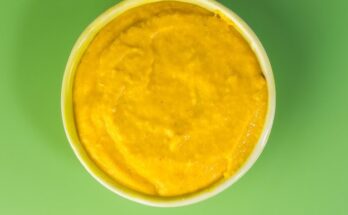Orange Roughy Recipe: Orange Roughy is a deep-sea fish known for its delicate flavor and flaky texture. Scientifically named Hoplostethus atlanticus, it’s caught in deep ocean waters, primarily around New Zealand and Australia. What makes Orange Roughy stand out isn’t just its taste—it’s the melt-in-your-mouth consistency and mild, slightly sweet flavor that makes it a favorite among seafood lovers.
This fish has a light, white flesh that’s perfect for absorbing spices and marinades. It’s an excellent canvas for a wide range of cooking methods, from grilling and baking to pan-searing. Unlike stronger-tasting fish like mackerel or sardines, Orange Roughy appeals even to those who aren’t usually seafood fans. Its firm yet tender fillet doesn’t fall apart during cooking, making it ideal for beginner cooks.
Moreover, it’s low in fat and high in protein, making it a healthy choice. It contains essential nutrients like vitamin B12, selenium, and omega-3 fatty acids. All these benefits combined with its gourmet-level taste make it a top pick for anyone wanting to whip up an impressive meal.
Why Choose Orange Roughy for Your Meals?
There’s a reason why chefs and home cooks alike love Orange Roughy. First, it’s incredibly versatile. Whether you’re aiming for a Mediterranean dish with olives and tomatoes or a more classic lemon-butter fish, this fillet fits right in. The flavor is subtle enough to work with many seasonings but distinctive enough to stand out on its own.
Second, it cooks quickly. On a busy weeknight, the last thing you want is a recipe that takes hours. Orange Roughy fillets typically cook in under 15 minutes, whether you’re baking, grilling, or pan-frying. That’s faster than most meats and delivers just as much satisfaction.
Third, if you’re watching your health, this fish fits into virtually any diet. Keto? Low-carb? Paleo? Weight Watchers? You’re covered. It’s also a great option for kids because of its mild flavor and soft texture.
And finally, it’s a fancy dish that doesn’t require fancy skills. Cooking Orange Roughy can make you feel like a Michelin chef without needing hours of prep or exotic ingredients.
Ingredients Needed for Orange Roughy Recipe
Fresh Ingredients You’ll Need
To create a delicious Orange Roughy dish, you’ll want to start with the freshest ingredients. Here’s a list of what you’ll need for a basic yet mouth-watering version:
- 4 Orange Roughy fillets (about 6 oz each)
- 2 tablespoons olive oil (or melted butter for a richer taste)
- 2 garlic cloves, minced
- 1 lemon (zest and juice)
- Salt to taste (about 1 teaspoon)
- Black pepper (freshly ground preferred)
- 1 teaspoon paprika (adds color and a smoky note)
- Fresh parsley for garnish
When shopping for Orange Roughy, always look for firm, white fillets with a clean scent. Avoid any that appear slimy or have a fishy odor—those are signs they’re past their prime.
Optional Add-ons for Extra Flavor
While the basic recipe is flavorful, you can easily elevate your Orange Roughy with a few extra ingredients:
- Cherry tomatoes: Add them to the baking tray for a sweet, roasted finish.
- Capers or olives: These give a Mediterranean vibe with a salty kick.
- Parmesan cheese: Sprinkle a bit before baking for a cheesy crust.
- Herbs: Dill, thyme, or rosemary can add an herbal aroma that pairs perfectly.
- White wine: A splash in the baking dish can infuse the fish with extra flavor.
These add-ons allow you to customize the dish based on your taste and what’s in your pantry. The beauty of Orange Roughy is that it’s like a blank canvas—it takes on the flavor of whatever you pair it with.
Tools and Kitchen Equipment
Basic Utensils Required
The great thing about making Orange Roughy is that you don’t need a gourmet kitchen. Here’s what you should have on hand:
- Cutting board and sharp knife (for prepping the lemon and garlic)
- Mixing bowl (to blend your seasoning mix)
- Spoon or brush (to apply oil or butter)
- Baking sheet or oven-safe skillet
- Spatula or fish turner (helps handle the delicate fillets)
- Aluminum foil or parchment paper (for easier cleanup)
These tools are likely already in your kitchen, so there’s no need for special gear.
Recommended Appliances for Better Results
If you want to level up your cooking game, consider using:
- Convection oven: Provides even cooking and helps with crispy edges.
- Air fryer: Yes, you can air fry Orange Roughy! It’s fast, and gives a golden crust.
- Indoor grill or grill pan: Perfect for adding those beautiful sear marks and a smoky flavor.
- Food thermometer: Helps ensure your fish is cooked to a safe 145°F without overdoing it.
These aren’t necessary, but they do add convenience and consistency, especially if you cook fish often.
Step-by-Step Instructions
Step 1: Preparing the Fish
Start by prepping your Orange Roughy fillets. If they’re frozen, thaw them completely in the refrigerator overnight or use the defrost setting on your microwave. Never cook Orange Roughy straight from frozen—it can lead to uneven cooking and a rubbery texture.
Once thawed, rinse the fillets under cold water and pat them dry with paper towels. This step is crucial because excess moisture can prevent the seasonings from sticking and result in soggy fish. Place the fillets on a clean plate or cutting board and inspect them for any bones. While commercial fillets are usually deboned, it’s always good to double-check.
After drying, lightly score the top of the fillets with a knife. These shallow cuts help the seasoning penetrate better and also create a more appealing look after cooking. Now your fish is ready to be seasoned!
Step 2: Seasoning the Fillets
In a small bowl, combine olive oil, minced garlic, lemon zest, lemon juice, salt, pepper, and paprika. Stir until the mixture is well blended. Using a spoon or brush, coat each side of the Orange Roughy fillets with this marinade. Make sure every inch is covered—don’t skimp on the edges or corners.
Let the fillets rest for about 10 to 15 minutes at room temperature. This not only allows the fish to absorb the flavors but also ensures more even cooking. If you’re planning ahead, you can marinate the fish for up to 2 hours in the fridge—just remember to take it out 15 minutes before cooking to bring it to room temp.
This seasoning combo provides a balanced flavor—garlic and lemon add zest, paprika adds warmth, and olive oil keeps the fish moist. For an extra layer of flavor, you can sprinkle chopped herbs like parsley or thyme over the top just before cooking.
Step 3: Cooking Methods – Baking, Pan-Frying, or Grilling
Now that your fillets are prepped and seasoned, it’s time to cook! Depending on your preference or kitchen setup, you can bake, pan-fry, or grill Orange Roughy. Here’s how to do each method right.
Baking Instructions
Preheat your oven to 375°F (190°C). Line a baking sheet with parchment paper or foil for easy cleanup. Arrange the fillets in a single layer, making sure they don’t overlap.
Bake for 12–15 minutes, depending on the thickness of your fillets. You’ll know it’s ready when the fish flakes easily with a fork and is opaque all the way through. For a golden top, you can switch to broil for the last 2 minutes—just keep a close eye to avoid burning.
Baking is the easiest method and retains the fish’s moisture, making it perfect for meal preps or feeding a crowd.
Pan-Frying Instructions
Heat 2 tablespoons of olive oil or butter in a non-stick skillet over medium heat. Once hot, gently place the fillets in the pan. Cook for about 3–4 minutes on each side, depending on thickness.
Don’t move the fillets too much—let them sear to develop a slight crust. Use a thin spatula to flip them carefully so they don’t fall apart. Pan-frying gives you a slightly crispy edge while keeping the inside moist.
Grilling Instructions
Preheat your grill to medium-high. Oil the grates well to prevent sticking. Place the fillets on the grill and cook for 3–4 minutes per side.
Grilling gives the fish a slightly smoky flavor that pairs beautifully with citrus marinades. If you’re worried about the fillets breaking apart, use a grill basket or place them on a sheet of foil.
Each cooking method brings out a different aspect of the fish’s flavor and texture, so try all three over time to find your favorite!
Step 4: Checking for Doneness
Don’t guess when your fish is ready—check! The easiest way is to use a fork. Insert it into the thickest part of the fillet and twist gently. If the fish flakes easily and is no longer translucent, it’s done.
Alternatively, use a food thermometer. The USDA recommends a safe internal temperature of 145°F (63°C) for cooked fish. Insert the probe into the center of the fillet—if it hits the mark, you’re good to go.
Overcooking is one of the most common mistakes with fish. Orange Roughy is delicate, so a few extra minutes can turn it dry and tough. Stick to the timing guidelines and check early if you’re unsure.
Serving Suggestions
Side Dishes That Complement Orange Roughy
Pairing your fish with the right sides can elevate your meal from good to unforgettable. Here are some popular and delicious options:
- Steamed or roasted vegetables: Think asparagus, broccoli, carrots, or green beans.
- Rice or couscous: Light grains balance the richness of the fish and soak up any extra sauce or seasoning.
- Garlic mashed potatoes: Creamy and savory, this classic side is always a hit.
- Quinoa salad: Packed with veggies, lemon, and herbs—it’s a health-conscious yet tasty option.
- Grilled corn on the cob: Adds a sweet and smoky element that complements the fish perfectly.
Pick one or mix a few for a well-rounded plate. Keep the flavors light and fresh so they don’t overpower the fish.
Garnishing Tips
Never underestimate the power of a good garnish—it can turn your dish into a visual masterpiece and enhance the flavor. Here are a few go-to garnishing ideas:
- Fresh parsley or dill: Adds a pop of color and freshness.
- Lemon wedges: Great for squeezing over the top right before serving.
- Microgreens: Trendy and beautiful, they give your plate a fine-dining feel.
- Toasted nuts (like almonds or pine nuts): Add crunch and a nutty aroma.
Just don’t overdo it. Garnishes should complement, not distract. A simple sprig of herbs and a lemon wedge can be all you need for a restaurant-quality presentation.
Nutritional Information
Health Benefits of Orange Roughy
Orange Roughy is not just tasty—it’s also a great addition to a healthy diet. This lean, white fish is an excellent source of high-quality protein, with about 20 grams per 3-ounce serving. It’s low in fat and carbohydrates, making it ideal for those following low-calorie or low-carb diets like keto or paleo.
One of the standout benefits of Orange Roughy is its omega-3 fatty acid content. These healthy fats are known for their heart-protective effects, including lowering blood pressure, reducing triglycerides, and decreasing inflammation. Omega-3s also support brain health, mood stability, and even joint mobility.
Orange Roughy is rich in vitamins and minerals like vitamin B12, phosphorus, and selenium. Vitamin B12 is essential for nerve function and red blood cell production. Phosphorus supports bone health, while selenium acts as a powerful antioxidant that can help protect cells from damage.
Despite all these benefits, it’s important to consume Orange Roughy in moderation due to its long lifespan, which can lead to higher mercury content compared to shorter-lived fish. The FDA recommends that pregnant women and young children eat it occasionally rather than regularly. For the general adult population, enjoying it once or twice a month is a safe and healthy practice.
Calorie Count and Macronutrient Breakdown
Here’s a nutritional breakdown for a standard 3-ounce (85g) cooked Orange Roughy fillet (without added oil or seasonings):
| Nutrient | Amount |
|---|---|
| Calories | 89 kcal |
| Protein | 20 g |
| Total Fat | 0.8 g |
| Saturated Fat | 0.2 g |
| Carbohydrates | 0 g |
| Fiber | 0 g |
| Sugars | 0 g |
| Cholesterol | 35 mg |
| Sodium | 150 mg |
These numbers will vary slightly depending on how you cook the fish and what ingredients you use. For example, adding olive oil or butter will increase the fat and calorie count. Still, Orange Roughy remains a nutrient-dense, low-calorie protein source suitable for many dietary needs.
Common Mistakes to Avoid
Overcooking the Fish
One of the easiest ways to ruin a good piece of Orange Roughy is to overcook it. Since it’s a lean and delicate fish, it doesn’t need much time on the heat. The moment it turns opaque and flakes easily, it’s done. Many home cooks make the mistake of “just giving it another minute,” which can turn a perfectly moist fillet into a dry, chewy mess.
To avoid this, always set a timer and keep a close eye during the last few minutes of cooking. Using a food thermometer can also help you get it just right. Pull the fish from the oven or grill as soon as it hits 145°F (63°C).
Another tip? Let the fish rest for a minute or two after cooking. Like steak, fish continues to cook slightly once removed from the heat. Resting allows juices to redistribute and keeps it moist and flavorful.
Using Too Much Seasoning
While seasoning is essential, Orange Roughy has a very mild and clean flavor that can be easily overwhelmed. Overdoing it with salt, strong spices, or oily marinades can mask the delicate taste of the fish.
Stick with light, complementary flavors. Citrus, herbs, garlic, and a dash of pepper are often all you need. If you’re experimenting with bolder ingredients—like soy sauce or spicy rubs—try them in small amounts first. Remember, it’s easier to add more seasoning than to take it away once applied.
Also, avoid heavily breading the fillets unless that’s the specific style you’re going for. A light crust or sear can be lovely, but too much breading can overpower the texture and essence of the fish.
FAQs about Orange Roughy Recipe
What does Orange Roughy taste like?
Orange Roughy has a very mild, slightly sweet flavor with a firm, flaky texture. It’s less “fishy” than many other white fish, making it a favorite for picky eaters or those new to seafood.
Can I cook Orange Roughy from frozen?
Technically yes, but it’s not recommended. Cooking from frozen can lead to uneven texture and longer cooking times. It’s best to thaw the fish in the refrigerator overnight or under cold running water before cooking.
How do I store leftover Orange Roughy?
Store leftovers in an airtight container in the refrigerator for up to 2 days. To reheat, warm it gently in a skillet over low heat or in the microwave for short intervals to avoid drying it out.
What herbs pair well with Orange Roughy?
Parsley, dill, thyme, basil, and rosemary are all excellent choices. These herbs complement the delicate flavor of the fish without overpowering it.
Is Orange Roughy safe for kids?
Yes, but in moderation. Due to its potential mercury content, it’s best served occasionally rather than as a daily staple for young children. Always consult your pediatrician if you have concerns.
Conclusion
Cooking Orange Roughy at home is a simple yet deeply rewarding experience. This mild, flaky white fish is perfect for both novice cooks and seasoned chefs. With just a few ingredients and less than 30 minutes, you can serve a dish that’s healthy, elegant, and packed with flavor.
Whether you choose to bake, grill, or pan-fry it, the key is in the preparation—keep it fresh, don’t overdo the seasoning, and watch the cooking time carefully. Paired with the right sides and garnishes, Orange Roughy transforms into a show-stopping centerpiece for any meal.
So next time you’re in the mood for something light, delicious, and fuss-free, give this Orange Roughy recipe a try. Your taste buds (and your dinner guests) will thank you!



